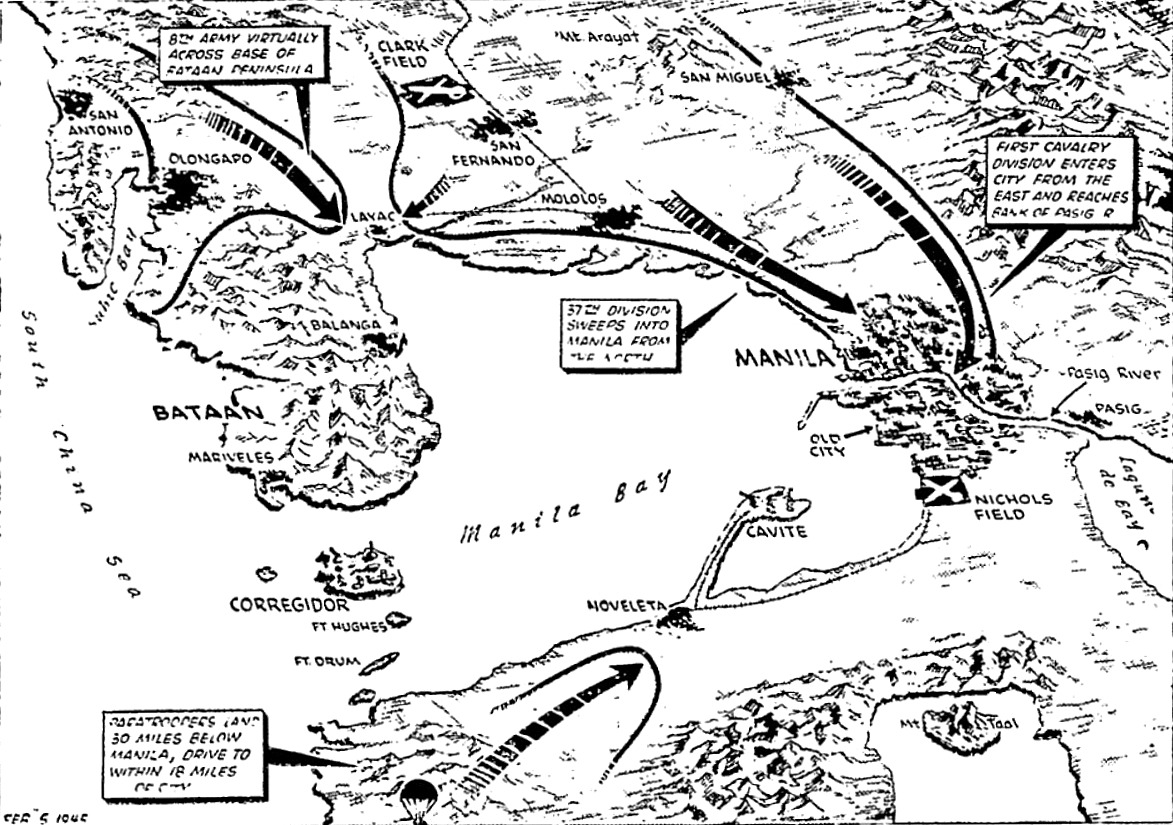The Pittsburgh Press (February 5, 1945)
Half of starving Manila freed by avenging Yanks
Japs in southern part of city burn buildings for last-man stand
The end of a long, hard road for Gen. Douglas MacArthur was the entry of U.S. troops into Manila from the north and east. Other U.S. forces were gaining against the Japs on both sides of Manila Bay.
MANILA, Philippines (UP) – Avenging U.S. troops seized control of virtually all the northern half of burning, starving Manila today.
The Americans freed 3,700 imprisoned American and Allied civilians and captured the Presidential Palace.
The 1st Cavalry and 37th Infantry Divisions stabbed into the heart of the Philippines capital from the east and north and rapidly were mopping up the last enemy pockets north of the Pasig River, which bisects the city.
South of the 200 to 300-yard-wide river, several thousand crack Jap Marines were blasting and burning docks, warehouses, bridges and other vital installations preparatory to what may develop into a last-man stand in the southern half of the capital.
Gen. Douglas MacArthur at last reports was waiting impatiently in the northern suburbs for the bridging of one last river for a triumphal entry into the city he was forced to abandon to its fate three years, one month and three days ago.
A CBS broadcast from Luzon said President Sergio Osmena and Resident Commissioner Brig. Gen. Carlos P. Romulo landed at a Luzon airport from Washington Sunday and headed south to join Gen. MacArthur in his return to Manila.
MBS correspondent Royal Arch Gunnison jubilantly reported that Manila had been “liberated,” but all other sources emphasized that the southern part of the city was still in Jap hands.
100-mile advance in 36 hours
The 3,700 American and Allied civilian internees were rescued by a mechanized flying column of the 1st Cavalry Division at the Santo Tomas University concentration camp in the heart of Manila Saturday night after a spectacular 100-mile advance in 36 hours.
Virtually all of the buildings in the camp area, including the infamous, ancient Bilibid Prison, had been cleared of Japs by last night. The Americans fought literally room to room for some of the buildings.
Brig. Gen. Williams C. Chase of Baltimore, who commanded the rescuing “flying wedge,” said the condition of the internees was “most pitiful.”
“They are practically skin and bones,” he said. “It would break your heart to look at them.”
Other elements of the 1st Cavalry Division pressed on to the north bank of the Pasig River and seized the Malacanang Palace, former residence of the U.S. governor general and later the seat of the Quezon government.
The 37th Infantry Division entered Manila from the north at 6:30 a.m. yesterday and by early afternoon was within a few hundred yards of a junction with the 1st Cavalry Division units at Santo Tomas.
Airfield in suburbs overrun
The infantrymen overrun the Grace Park airfield in the northern suburbs of Manila. Though pitted by U.S. bombs, it was expected to be repaired quickly. At least one artillery observation plane has already landed there.
Both the 1st Cavalry and 37th Infantry Divisions met only sniper and machine-gun fire in their advances into the capital, but fierce fighting was expected when they attempt to force the Pasig to clean out the remainder of the city.
“It may be a hell of a job,” one high officer said. “It may be several days before we have the city cleared out, but the Japs have no chance now.”
The Jap garrison was doomed to death or surrender. Its escape to the south had already been cut off by the 511th Paratroop Regiment of the 11th Airborne Division, which seized Tagaytay Ridge and city 30 miles below the capital Saturday morning.
By Saturday night, the paratroops were only 18 miles south of Manila and advancing against light opposition.
The 11th Corps, moving toward Manila Bay fropm the west coast of Luzon, was believed on the point of sealing off the Bataan Peninsula.
The 1st Cavalry and 37th Infantry Divisions found northern Manila little damaged, thought several fires were burning in the area. Great clouds of smoke from the area south of the Pasig River, however, cast a huge pall over the capital.
First observation indicated the Japs for the present were confining their demolition below the Pasig to bridges, warehouses, supply dumps, docks and other similar installations and not indulging in blind destruction.
The demolitions shook the ground for a radius of 20 miles about Manila and for a time there was an explosion every 10 minutes. An observer who flew over the city said the National City Bank Building appeared to be smoking, but the Bayview and Manila Hotels were intact.
Even should the Japs not scorch southern Manila, heavy resistance on their part might force the U.S. command to use artillery and bombers against the fortified area, resulting in major destruction.
The 1st Cavalry Division jumped off from the Guimba area of central Luzon Friday for its 100-mile dash into Manila. Several hundred Japs were slain as the flying columns smashed through enemy pockets in a wide, enveloping sweep that carried through the hills to the east of the capital.
Captured intact were the Novaliches watershed and great dam and reservoir some 20 miles northeast of Manila. It was possible, however, that the Japs destroyed the pumping station inside Manila since city water was cut off in at least some sections of the capital.
Manila Bay, one of the world’s largest landlocked harbors, was reported a graveyard of sunken ships, most of them destroyed by U.S. aerial bombs but some scuttled by the Japs.
A Jap Domei broadcast said U.S. troops landed Jan. 18 on Kolo Island, largest of the Sulu group in the Southwest Philippines midway between Mindanao and Borneo, with a force of 3,000 troops and more than 10 tanks.
U.S. Liberators attacked enemy installations on Corregidor Island in Manila Bay Friday and next day hit the Cavite Naval Base, just south of Manila, causing many fires and explosions.
Attack bombers struck enemy defenses at Balor Bay on the east coast of Luzon, while fighters badly damaged two enemy destroyers off the north coast.
Light naval units strafed coastal installations and damaged seven beached barges in Salomague Harbor north of Vigan on the northwest coast of Luzon.

